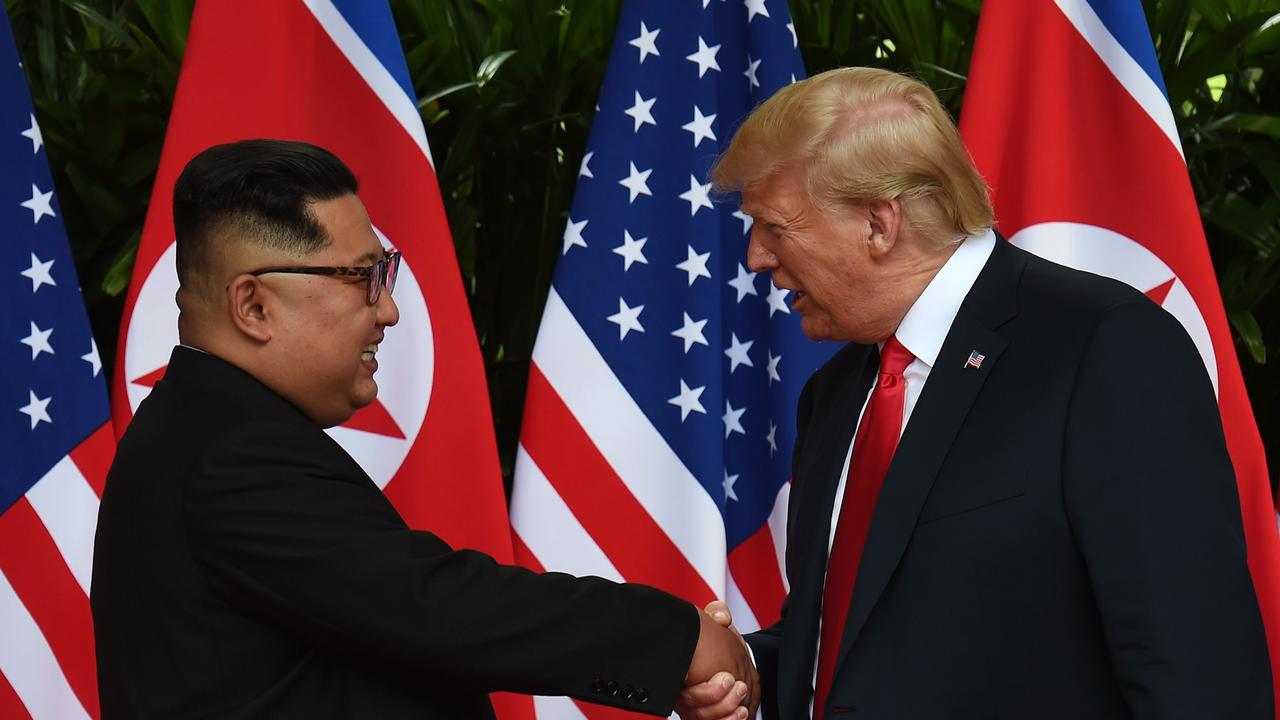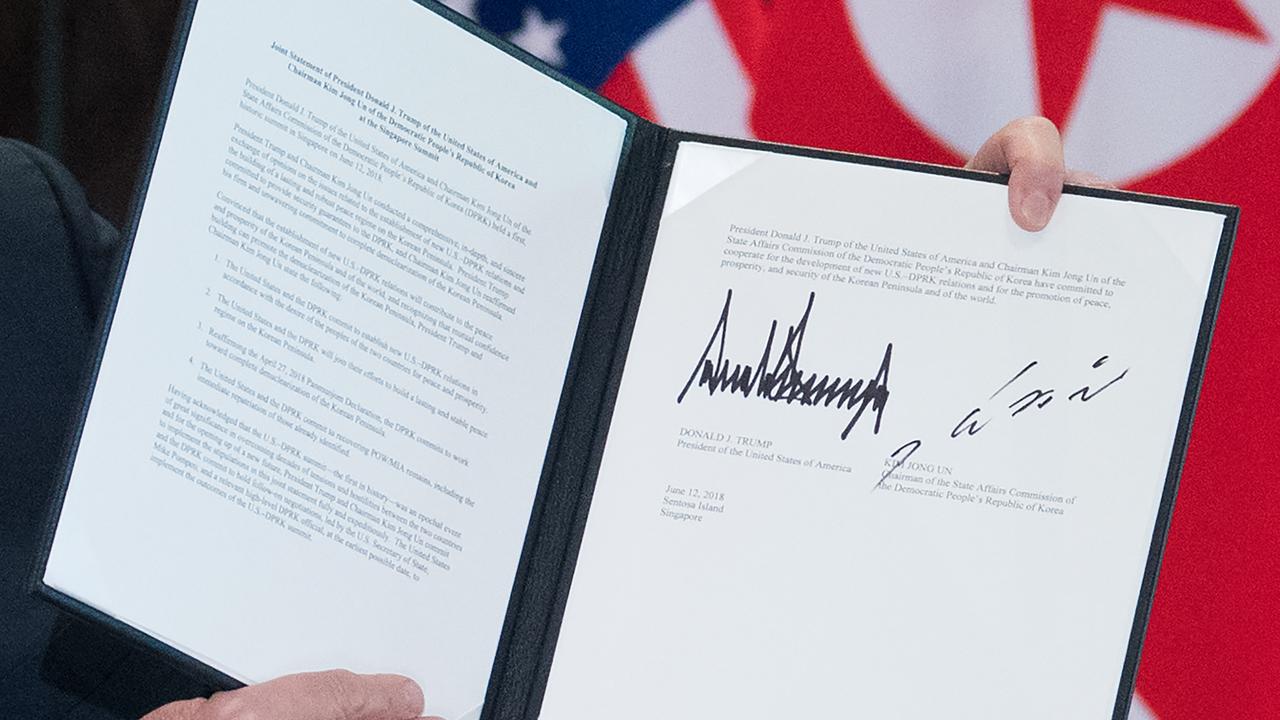How North Korea’s state media covered the summit
NORTH Korea’s state media has published its account of the historic Trump-Kim summit. But there’s one big detail missing from the reports.
NORTH Korea’s state media has published its account of the historic summit between Donald Trump and Kim Jong-un.
The North Korean dictator personally invited the US president to come to Pyongyang, the Korean Central News Agency (KCNA) reported.
“Kim Jong-un has invited Trump to visit Pyongyang at a convenient time, while Trump has invited Kim Jong-un to visit the United States.”
It claimed Mr Trump accepted the offer “with pleasure”.
“Both leaders with pleasure accepted each other’s invitations, knowing positively that it would be another important event for DPRK (Democratic People’s Republic of Korea) and US relations,” the agency said.
Mr Trump made no mention of the invitation in his post-summit tweets this morning, and the White House is yet to confirm or deny the reports.
The North Korean media is known for its colourful, gushy coverage of its reigning leader. So how did it report on the most significant meeting of Mr Kim’s life?
HOW NORTH KOREA COVERED THE SUMMIT
KCNA’s coverage of the historic meeting between the American and North Korean leaders was uncharacteristically warm.
“Noting that he is pleased to sit face-to-face with President Trump and the U.S. side’s delegation, Chairman Kim Jong Un highly praised the president’s will and enthusiasm to resolve matters in a realistic way through dialogue and negotiations, away from the hostility-woven past,” the hermit nation’s state media report said.
It repeatedly referred to them as "the two top leaders”, and notes that after the working lunch, the “top leaders had a walk, deepening friendly feelings”.
“Chairman Kim Jong Un and President Trump expressed expectation and belief that the two countries which have lived in the quagmire of hostility, distrust and hatred would pass the unhappy past over and dynamically advance toward an excellent and proud future beneficial to each other and another new era, the era of the DPRK-U.S. cooperation would open up.”

BIG DETAIL MISSING FROM REPORTS
The denuclearisation of the Korean peninsula was the main end goal for the United States in meeting with Kim Jong-un.
But the KCNA report made just two fleeting references to it — neither of which included a direct pledge to actually do so.
The first reference states: “Kim Jong Un said in order to achieve peace and stability of the Korean Peninsula and realise its denuclearisation, the two countries should commit themselves to refraining from antagonising with each other out of mutual understanding, and take legal and institutional steps to guarantee it.”
The second states: “Kim Jong Un and Trump had the shared recognition to the effect that it is important to abide by the principle of step-by-step and simultaneous action in achieving peace, stability and denuclearisation of the Korean Peninsula.”
Neither of these statements suggests the two leaders reached a concrete agreement that will ensure North Korea gives up its nuclear weapons.
Rather, it says the two countries should maintain a peaceful relationship if the prospect of denuclearisation is ever to be realised.

In a separate report, KCNA acknowledges the joint text signed by the two leaders, which specifies four key agreements between the US and the Democratic People’s Republic of Korea (DPRK).
Again, this doesn’t actually specify a concrete plan for denuclearisation, but rather just reiterates a symbolic deal established between North and South Korea in April.
Here’s what the document said — and a brief explanation of what each point means:
1. The United States and the DPRK commit to establish new US-DPRK relations in accordance with the desire of the people of the two counties for peace and prosperity.
This serves as an acknowledgment that the US and North Korea are seeking to leave their hostilities behind and move towards peace.
2. The United States and the DPRK will join their efforts to build a lasting and stable peace regime on the Korean Peninsula.
Until now, the US and South Korea have had an alliance against North Korea and its nuclear regime. This means the US and North Korea will move towards dialogue and pursue an end to their hostile relationship.
3. Reaffirming the April 27, 2018 Panmunjom Declaration, the DPRK commits to work toward complete denuclearisation of the Korean Peninsula.
The Panmunjom Declaration was adopted by North and South Korea during the 2018 inter-Korean Summit in April. It stated that the two sides would agree to work together to end the Korean War and bring about a new era of peace, including denuclearisation. This point serves as a reiteration of that.
4. The United States and the DPRK commit to recovering POW/MIA remains, including the immediate repatriation of those already identified.
The United States and North Korea will work together to identify the remains of American Korean War casualties — a move veterans advocates have been pushing for. Over 7000 American service members from the war remain unaccounted for.
A third KCNA article acknowledges Mr Kim received a letter from Singaporean Prime Minister Lee Hsien Loong.
The letter congratulated the leader for the “successful conclusion of the historic summit meeting” and said Singapore believed it was an “honour” to sponsor him and Mr Trump.
Mr Lee also wrote that he hopes to meet Mr Kim again in the near future.



